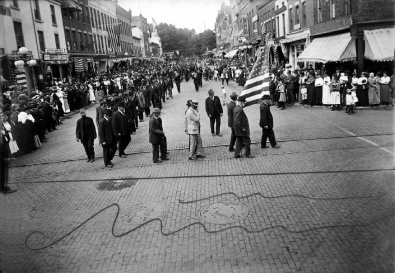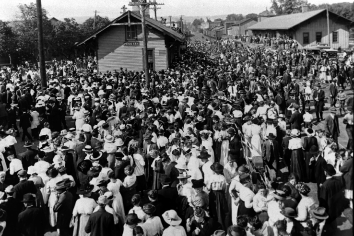|
World War I: The Yates County Homefront (1917 - 1918)
Yates Past - November 2008
People with an interest in history know that before November 11th was called Veteran’s Day it was called Armistice Day. That commemorated the day when the truce was signed ending the Great War in Europe. It was signed by German generals on a railroad car near Reims, France at the 11th hour of the 11th day of the 11th month in 1918. After we had to go through a second world war which was more costly than the first and then the war in Korea, legislation was passed and signed by President Eisenhower in 1954 changing the name to Veteran’s Day.
Here at YCGHS we have an old scrapbook that someone meticulously assembled during the first world war and it eventually was donated to us here at the historical society. It includes newspaper clippings from local newspapers. The first page has a clipping dated April 8, 1917 which reads “President Asks Congress To Declare State of War”. Toward the end of the scrapbook is a headline dated December 3, 1918 that reads “President To Sail Tomorrow; Allies Decide on Kaiser’s Fate”. The scrapbook chronicles the entirety of America’s involvement in the war. (It should be remembered that the war in Europe went on for two years and eight months before we got into it.) All that follows in this article was gleaned from that scrapbook.
In February of 1917 there were 322,000 men serving in the American military. By October of that year that number had swelled to 1,675,000. Local newspapers were filled with the names of those Yates County men who enlisted in either the army or the navy. President Wilson called for the first Selective Service Draft in May of 1917 and the first was held in Yates County in July. Over 1,500 men in the county had registered but the county’s quota for that first draft was 122. The first man selected was Claude Kennedy of Italy. The first five draftees left Penn Yan on September 9th. The four Penn Yan fire companies and the Penn Yan Band promised a “Monster Demonstration” to send them off and they delivered. The evening the five men left for Fort Dix, New Jersey over a thousand people showed up in the park in front of the Yates County Courthouse to hear speeches by local officials and to hear the community band play patriotic music. Then the entire group accompanied the five men in a torchlight parade all the way down to the Pennsylvania Railroad depot on East Elm Street to see them off. That set the pattern for each group of enlisted and drafted men when they left Penn Yan; ceremonies, parades, and large crowds to send them off. The Selective Service eventually banned those send off parades in August of 1918 because they disrupted the train schedules. By October of 1918, there were over 500 Yates County men serving in the military.
 The parade down Main Street, September 1917 The parade down Main Street, September 1917
Civil War veterans lead the way
|
|
 The crowd at the railroad depot The crowd at the railroad depot
at the Jacob Street crossing (now East Elm Street).
The passenger depot was to the left and the
freight depot to the right (now Morgan's Grocery).
|
After they left Penn Yan, those men went to one of several training camps; Fort Dix in New Jersey, Camp Meade in Maryland, Fort Slocum on Long Island, etc. It was six months (October of 1917) before U.S. troops were ready for combat and shipped “Over There”. The “Sammies” as the newspapers called them (Uncle Sam’s boys) first saw action against the Germans in late October and the first casualty lists trickled back to the States shortly thereafter. The first troops sent to France were generally from the South and the West. Yates County boys didn’t join the fighting until the Spring of 1918. The first news of a war death hit Yates County in April. Charles Costello of Penn Yan , age 25 died of meningitis onboard a transport ship bound for France. He was buried in France, but a memorial service was held in St. Michael’s church. Every business in Penn Yan closed the morning of the service to honor his death. The first combat-related death was reported in May. Harold Johnson of Torrey (age 20), a member of a machine gun battalion, was killed in the attack of the French village of Cantigny. From that point until the end of 1918, there was a steady flow of names of Yates County men killed in combat; six in September, eighteen by the end of October, etc. That summer and early autumn saw the biggest battles in which American troops were involved as they pushed back and eventually collapsed the German lines and pushed them back to the border of Germany itself. By late October 1918 Germans rioted in the streets of Berlin and attacked the Imperial Palace. Kaiser Wilhelm abdicated his throne and fled into neutral Holland. Leaders of the German provincial government then telegraphed the French and Americans that they were ready for an cease fire (armistice). That led to this article from the Yates County Chronicle:
Monday, November 11, 1918 will go down through the pages of history as the date of one of the most important happenings ever recorded. After more than four years of war in which the leading nations of Europe were involved, the end of hostilities was announced on that day. An anxious world had been on the qui vive (on the alert) for three days, awaiting the decision of the German government in relation to the terms of the armistice submitted by Commander Foch of the Allied Armies. Because of a premature announcement on Thursday, a number of Penn Yan’s businessmen assembled Saturday morning and made arrangements for a celebration to be held after official announcement of Germany’s surrender was made. At 2:45 Monday morning the official announcement was sent over the wires from Washington. At 3:45 the fire bell in Penn Yan carried the glad tidings to every home here and a few minutes later the church bells were also pealing forth the message of a victorious peace. A large number of people soon congregated in the street and the noisiest day Penn Yan has known in a great many years was soon in full swing. A big bonfire was started in the middle of the street at the four corners which was kept burning until afternoon. The celebration planned for Monday night was a complete success. At 7:15 when the parade started from the foot of Main Street, headed with Birkett Ferenbaugh carrying a large American flag, there were several thousand people between that point and the Arcade block. Civil War veterans were given the place of honor at the head of the line. Following came the police, members of village boards, county officers, fire department, New York State Guard, clergymen, Red Cross workers, Boy Scouts, Girl Scouts, Penn Yan Band, and several thousand plain American citizens armed with tin pans, tin horns, drums, cowbells, hand bells, and various other kinds of home-made noise devices. Colored lights were kept burning along the line of march and Roman candles and rockets were fired off in the air. The parade marched to Head Street, countermarching to Boundary Street, thence back to the starting point where a program of speaking and singing was carried out, none of which could be heard fifty feet away because of the noise. At the conclusion of the exercises, an effigy of the Kaiser, which had been carried in a box resembling a coffin on the shoulders of four men in khaki, was burned.
The old scrapbook is a valuable resource for anyone researching a family member who lived in Yates County at that time and served in the military during World War I. The clippings include many letters from servicemen that were published in the newspapers. The letters described their training camp experiences, the sea voyage over to France, and of course their experiences along the Western Front. In addition to the letters there are many short articles about servicemen and their experiences submitted by their families. There are also many photographs of men in uniform which were run in the local papers. It will be available to researchers in the Research Center of the Underwood Museum. Unfortunately, it’s not indexed. Now there’s a good project for a volunteer!
by Rich MacAlpine
|
